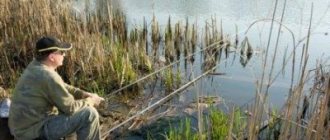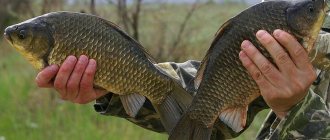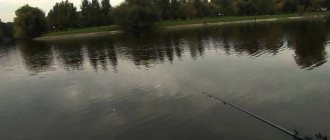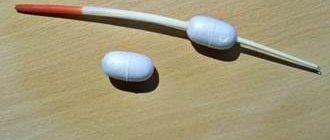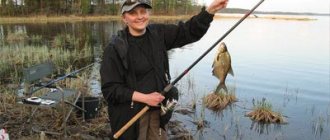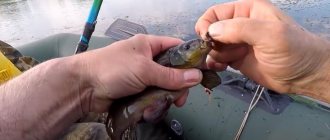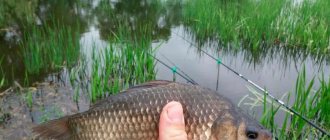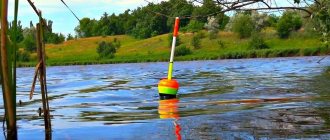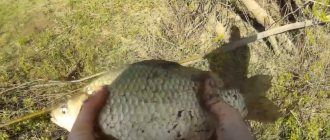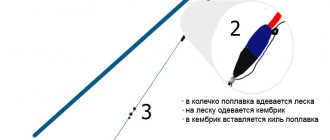Bleak can be used for live bait fishing, and due to its high fat content, it has a unique taste when fried or dried. Bleak fishing is most popular in March, April, May, and June, and the best tackle for such fishing is a float rod.
In this article you will learn how the tackle should be structured, which rod to choose for the best bleak fishing in spring and early summer, and you will also be able to watch a video of the fishing process.
Where to catch bleak
In search of food, the fish roams throughout the entire reservoir, so there are no difficulties in choosing a place to catch it; you only need convenient access to the water section.
plant thickets , preferring clean, open water. Natural timidity forces it on windless days not to approach the coastline closer than ten to fifteen meters, unless spawning has begun. During currents or during strong winds, waves create a certain safety, and a school of fish approaches the shoreline within the distance of a fishing rod.
For spring bleak fishing, small shallow waters and coastal places with a depth of no more than three meters, open to sunlight, are recommended.
What to fish with
Fish is not picky when choosing food. If desired, you can catch it with whatever is at hand.
Since the fish has a fairly small mouth, it is better not to use dough or bread as bait. Otherwise, the bleak will only peel off the bait, you won’t have time to hook it and get it to the shore.
It is better to make microscopic-sized balls from the above-mentioned baits and try to fish with them. However, in the case of intense biting, this method is not convenient. Ideally, fish with maggots. It has quite strong skin that can withstand several bites, it is distinguished by its small size and ability to live for a long time in water.
Bleak behavior in spring
In the spring season, before the start of spawning, the fish begin to eat.
The bleak seeks to gain strength after winter in preparation for this event. During this period, both small fish and individuals that have managed to spawn can bite. With the beginning of March, bleak begins to actively take an interest in any bait. If the ice is strong enough, fishing begins there.
April for fishing is characterized by the fact that you have to look for a good place. This is done quickly, since bleak is characterized by noisy behavior, and its feeding places are easy to determine. From the first days of this month, bleak is preparing for spawning, which begins after the water warms up to fifteen degrees. Its bite lasts from sunrise until ten o'clock, then its activity decreases sharply, and only in the evening the fish becomes active again.
In May, the daily increase in water temperature causes the bleak to change tactics and slide down to depths of one and a half meters. But the fish continues to attack the bait greedily and confidently. Fishing in cold regions can continue from June until July.
Fishing tips
The active bite of the high water provides a skilled fisherman with a large catch; sometimes it is possible to catch more than 100 fish in 1 hour of fishing. Secrets of catching bleak in spring:
- bait makes sense, although some anglers claim the opposite. More fish swim to the place, and large individuals displace small ones. The bait mixture is based on crackers, pearl barley, pea porridge, animal feed is also added, and earth or clay is added to impart plasticity;
- tap water is not suitable for preparing the mixture; it is better to collect it from the reservoir where fishing takes place;
- It is better to use small baits; large baits rarely bite, but the prey is larger;
- it is preferable to make blind equipment with small hooks;
- when biting, it is important to make sharp hooks, otherwise this frisky fish will quickly leave;
- The bleak has soft lips, so you should prepare for frequent gatherings.
Originally posted 2018-08-21 13:41:24.
Float rod equipment
The bleak is caught on a fishing rod. You can use light tackle, because the fish are not very large. For instant hooking, the rod test should be as light as possible.
The fishing rod for float fishing is taken as a fly rod. For casting at close and medium distances, rods of 3-4 meters are quite sufficient. The rod should be extremely light, up to 120 grams.
Options for loading a float when catching bleak on a float. 1 heavy pellet or several medium pellets. With a few medium bites, the bite is felt better when fishing in the current.
Floats for catching bleak
Loading and float underwater
The equipment must ensure smooth immersion of the nozzle into the water column. For this reason, the main requirements for it are light weight and sensitivity of the float. You must be prepared for the fact that it is quite difficult to control such tackle when casting to the required distance, especially in windy weather. Therefore, the fisherman must “feel” the fishing rod when equipping it, create excellent flight characteristics, so as not to experience problems when catching bleak.
Video on making float equipment for bleaching:
Float and weight
Variations of “spindle” type floats.
Click to enlarge. The total weight of the equipment should be light and acceptable for weather conditions and the length of the fishing rod. In calm weather, it is recommended to use equipment from 0.5 to 1 g , and in strong winds with a side direction, the weight of the equipment is increased to 2 g .
The float (5-8 cm, about 0.3 grams) is loaded as much as possible, only the small tip of its antenna remains above the surface of the water. Due attention is paid to loading, since the float should sink even with small bites.
The recommended float shape is spindle-shaped . It is better not to use other types with long antennas, since in the spring bleak is mainly caught off the coast.
fishing line
Many people use 0.1 mm fishing line. A thinner one will get tangled, and a thicker one will not allow the use of light equipment. If the bite is weak, it is allowed to use a leash that is thinner than the main line and does not exceed seven centimeters in length. This measure will allow you to instantly distinguish a bite.
Pin Hook from the owner is quite suitable Hook size chart 0.1mm, lb 6, 300m
Hook
For catching bleak in the spring, a hook with an elongated shank and a straight bend is best suited. A hook point that is concave inward will require more time to remove the bleak from the hook, and the fishing rate will decrease. Excessively thin hooks are also not suitable - the percentage of failures increases. Recommended room sizes are 18, 19 and 20.
Lures for catching bleak
Maggot is a classic bait for catching bleak in the spring.
In the spring, maggot works best for catching bleak. It is not only considered tasty for bleaking, but is also more convenient - one large larva can catch at least a dozen fish. To attract bleaks, they use not only white maggots, but also red and even yellow ones.
If the bleak is not biting too actively , use a large bloodworm as bait - it does not fly off the hook for long enough.
If there is no suitable attachment, the bleak is caught on bread crumb or dough. Such baits are bad because the fish eats them quickly or knocks them off completely.
Some tips on bleak fishing techniques
You need to know how to use any of the right gear. Firstly, I advise you to forget about the usual casting from under the hand or from the side. The cast needs to be sharp, from behind the back, which is why a shortened fishing line is needed. The equipment should lie on the surface of the water in a straightened state along its entire length. Then equipment overlaps and inaccurate casts are eliminated. During casting, all flaws in the gear are revealed. It often happens that the equipment does not fly. Apart from weather disturbances such as wind or heavy rain, there are two reasons: the first is that the chosen rod is bulky and not suitable for casting light structures, the second is related to the first - the equipment is too light for the given fishing conditions. Heavier equipment will be needed if you increase the thickness of the fishing line or when you have to fish with a large descent in the current.
Finally, the first cast is made. But don’t rush to immerse yourself in contemplation of the float against the backdrop of the landscape. Without waiting for the float to take a vertical position, quickly recast, or even better, several sharp, quick blows with the equipment on the water in the bait area. Bleak instantly reacts to the fall of any object into the water and is interested in what has fallen. After several such hits of the rig on the water that attract fish, throw it and wait until the float sinks to the antenna. If there are no bites within two to eight seconds, rethrow the rig 10-20 cm to the right or left. If this does not cause a bite, quickly change the descent. It is impossible to predict whether it needs to be increased or decreased; it must be felt. Actually, the whole technique for catching bleak comes down to re-casting the equipment as quickly and accurately as possible, throwing in small portions of bait, and changing the descent.
After several greedy bites, the bleak begins to try and throw the bait. On equipment weighing about 0.2-0.4 g, such touches of the fish to the bait are clearly visible. To get the fish to bite, you need to do the wiring. That is, after casting the rig, as soon as the float takes a vertical position, you need to move the rig with the rod in one direction or another. The wiring speed is selected in each specific case. Often, instead of uniform, wiring with short twitches of the equipment helps. Fall wiring is very effective. When the rig touches the surface of the water, you should immediately drag it very slowly to the side, while the speed at which the bait falls decreases. The slightest touch of the fish on the falling bait becomes visible at any stage if the line is constantly stretched.
Fishing method and process
Bleak is caught using a plug or fly rod, depending on the fishing conditions. If bites are frequent, then the weight of the rod will quickly tire your hands, and the plug version will not be so good.
Some people catch bleak by fly fishing. The gear is quite complex; you need to know how to use it correctly. Bleak can also be found on bottom gear designed for large fish.
Still, the best option is considered to be a float rod for fishing from the shore.
Remember that bleaks are mainly interested in baits that are in motion. If the bait remains inactive for a long time, the fish will ignore it. To attract bleak, you should periodically drag the fishing rod to create the appearance of bait activity. To do this, the tackle is re-cast or lightly twitched with the rod tip.
The bite should be immediate, as the bleak quickly eats the maggot.
Feeding bleak
Fishing begins with scattering bait (two to three handfuls) at the intended fishing points to form an area for bleak accumulation.
As a rule, it forms a circle of half a meter in diameter around the float. The complementary food is scattered with a damp hand so that it does not stick to the palm. The first portion is sent away, the remaining portions are gradually brought closer to you. The scattering is carried out in small portions to create cloudy columns. For warm water, the fishing depth is set to 30-40 centimeters, and in cool weather the fish prefers to stay near the bottom or at half-water. As a rule, the flock approaches within 5–15 minutes, but sometimes active biting begins already from the first cast.
In order for the bleak to more actively take the bait , the frequency of feeding increases - the cloudy column should settle to the bottom slowly. If there is no bite, or the fish activity is weak, change the bait or fishing depth. It is very important to find the level at which the flock stands.
If there is a forced break in fishing , associated, for example, with replacing equipment, you should not interrupt feeding - the school of fish may move to the side. To prevent this, tie a piece of dried bread to a rope and let it float on the surface of the water.
Strawberry flavor is a classic for catching bleak
You can buy bait at the store or prepare it yourself. In the first case, compositions are selected that are intended specifically for bleaking or for other small fish that stay in the upper water layers.
If you decide to prepare
complementary foods with your own hands , there is a fail-safe recipe :
- Semolina and bran are mixed in a ratio of 1 to 3.
- You can add a small amount of crushed bread crumb to the resulting mass.
- For every three liters of complementary food, one glass of milk is poured in to create the necessary turbidity, which attracts bleak.
- Soak the resulting porridge with water from a reservoir.
There is a simpler option, suitable for preparing complementary foods directly on the pond - fresh white bread is mixed with sand from the reservoir in which you will be fishing.
How to make a float for catching bleak and other small fish
The basis of the float should be a light but durable material, you can take balsa, but this is very expensive. The easiest way is to use a wine cork or a piece of foam.
A cylinder of the desired size is cut out of foam plastic; the larger the size of the cylinder, the greater the windage it has, and if you want to fish on a river with a fairly strong current, this may create some inconvenience.
float for catching bleak
Advice:
Since the cost of such a float is negligible, you can make several different sizes and experimentally select the right one directly on the reservoir.
So, let's continue making a float with our own hands for catching bleak.
The resulting cylinder should be cut lengthwise, after drilling a hole in its middle. Drill diameter 2 mm.
Now a rod is glued into the resulting longitudinal groove (from drilling). A lead plate of the required weight is glued to the second half. The mass is selected experimentally.
Advice:
The rod can be anything. It could be a simple toothpick, or it could be a wire. But wood, in my opinion, is better.
Next, these 2 halves are glued back into a cylinder.
Antenna
Now it's time to make an antenna for our bleak float.
The antenna can be made of wood or plastic; it is very convenient to use a lollipop stick (or analogues) - just not white, but green or red.
A hole is made in the middle of our cylinder with a diameter equal to the diameter of the antenna (or slightly less). The hole is made so that the antenna is perpendicular to the lead plate along the entire longitudinal axis of rotation of the antenna.
Now all that remains is to glue the antenna into the float and select a suitable cambric.
To reduce the windage of the float, you can “sharpen” it from the ends to a cone.
All that remains is to paint it, and you can go to the pond for testing... or you can just do it in the bathroom)
Advice:
Many people mistakenly believe that floats should be dark, at least in the keel part. I fundamentally disagree with this.
We see the pond as dark, because... light is scattered in the water and is not reflected from the bottom, but if you look from the water, you will see not the bottom, but the sky. For this reason, I believe that the floats should be painted a light gray... like military helicopters or airplanes. The antenna, naturally, should be made bright and noticeable, but not large.
A couple of tips and tricks
To attract bleak, you should use tasty and aromatic complementary foods. For this purpose, flavorings with subtle odors of fresh fruit . Vanilla and dill oil work great.
To attract fish, use simple methods:
- Create splashes on the water. To do this, scoop up water with your palms and throw it onto the float. The flying spray will attract the long-awaited fish:
- At the fishing point we create turbidity. A piece of clay or earth is taken from the shore and thrown to the float. The bleak likes the mud, it begins to look for food in it, and your bait is best suited at this moment.
- To increase the activity of bleak, it is recommended to use dusty baits that do not contain large pieces. The base should be flour, bran, egg powder and other ingredients. If you have to fish in the current, there is no point in using bait - the mud will be carried away by the current, and at the same time a school of bleak will leave with it.
To make finding fishing spots easier, use the following tips:
- If you have to fish in a quiet bay of a river, look for bleak near the shore - this is where its mass feeding occurs;
- Check out the shallows along banks that have rip currents. A school of fish stands in the zone of “quiet” water, constantly moving in the direction of the direct and reverse flow of water, looking for food;
- At the end of spring, bleak gather in large flocks, choosing feeding places near the water surface. You can find such points by the signs of pike hunting - bleak is included in its diet.
When attaching bait, we leave the tip of the hook a little open - this reduces the number of trips, and hooks are more effective.
Mounting a fishing rod on a bleak
Installing the equipment for a bleak is practically no different from the equipment for a float fishing rod. A fishing line is tied to the rod or reel, a float and a weight are attached to it, and then a leash and hook are attached to the main fishing line using fishing knots.
Equipment with fine settings is not as important for a simple amateur fisherman as for a sports fisherman. It is in sport fishing that gear adjustment comes to the fore, because prizes in the competition are at stake. More information about the installation of bleaching gear can be seen in the video from the TROPHY TV Channel.
Lure
Bait for bleak should be highly dusty, creating a cloud of turbidity. Bleak baits should contain as few large fractions as possible. The main components of such baits are bran, various flours, egg powder, etc.
If fishing is carried out in a strong current, it is not advisable to use bait, since the fish will swim away along with the cloud of turbidity. Most often, when catching bleak, bait is not used, since once you find a school, you can keep it in place by throwing sand into the water.
Conclusion
As you can see, in theory there is nothing complicated, but in practice you just have to try and everything will work out right away. You should not neglect such a fish as bleak, besides, it is caught at a time when the rest of the fish are sick after spawning, and this is another reason to go fishing once again.
Someone will probably be interested in what to do with such a small catch? In fact, there are a lot of options. Bleak can be dried, fried, made into sprats, some salt it like sprat, in general there are many options.
Personally, I don’t like to clean it; when I get home, I wash it thoroughly, then cover it with salt, and put it in the refrigerator for a day, after which I dry it. Dried bleak turns out to be very oily and also dries quickly.

